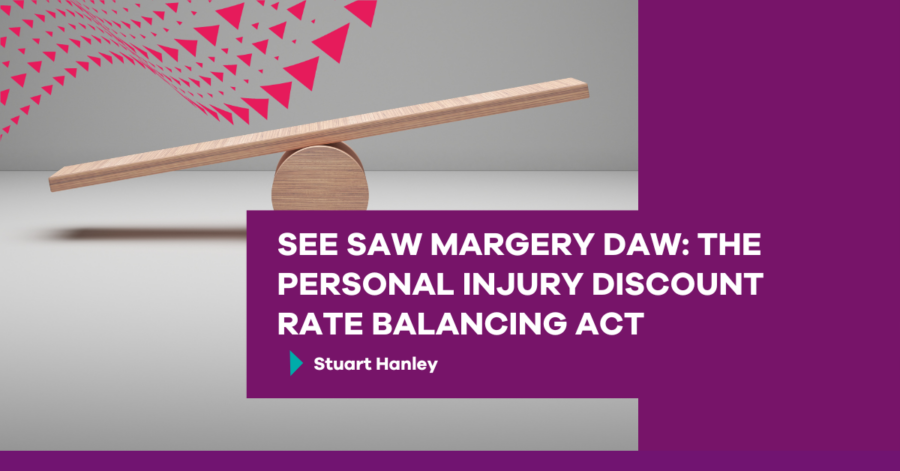See Saw Margery Daw: The Personal Injury Discount Rate balancing act


Revisiting the Personal Injury Discount Rate (PIDR)
Much of the focus on the Civil Liability Act (CLA) has always tended to be about the whiplash tariffs, mixed injuries, and the small claims track limit.
But the third key part to 2021 reforms, the Personal Injury Discount Rate (PIDR), has come to the fore again.
The government is currently seeking evidence to inform the second review of the PIDR using the process introduced by the CLA. The Call for Evidence closes on 9 April 2024 and the government should then publish a response document by July 2024.
The PIDR represents what the real rate of return is expected to be on the lump sum of compensation the claimant receives and is able to invest for future losses, costs and expenses. As part of the 100% compensation principle, it should ensure that people receive the full compensation that they were awarded – no more or less – by taking into account what they are likely to earn on that money before they are expected to have spent it.
In 2017, the PIDR was lowered from plus 2.5% to minus 0.75%. In July 2019, it was increased to minus 0.25% due to concerns that the lower 0.75% rate risked claimants being over-compensated and a view that the process should be based on what a ‘low’ risk investor would do as opposed to a ‘very low risk’ investor, which had been a test used before.
Call for Evidence
The current Call for Evidence is intended to assist the PIDR Expert Panel in the process of obtaining up-to-date data and information on a wide range of topics relevant to modelling claimants’ likely return on investment. This includes:
Timescale
Under the CLA, the PIDR must be reviewed within five years, which following the last rate change in July 2019 leads to the current target date of July 2024. The timing of the call for evidence and prioritisation of this by the MoJ over other matters such as the MedCo consultation suggests that the government remains on track to announce any new or perhaps even dual rates in July 2024.
Before the CLA reforms, there were no fixed intervals for the periods between which the PIDR was set. Prior to the last rate change in 2017, the previous one was set in 2001.
PIDR and the compensation see saw
A reduced PIDR rate increases compensation awards, meaning compensators face paying out higher sums and, crucially, larger sums than they may have reserved funds for at the outset of the claim.
An increased PIDR reduces compensation awards, meaning some claimants may not achieve 100% recovery and risk running out of funds in the future for ongoing care etc. The PIDR is a balancing act that I imagine as a compensation see saw. While the discount rate goes up, compensation goes down, and vice versa.
The human impact
We don’t often see Liz Truss quoted in the personal injury sector but when she was Lord Chancellor in 2017, she perhaps summed it up well when she stated “(claimants) are financially dependent on this lump sum, often for long periods or the duration of their life”.
So while PIDR might seem like a technical aspect of legal proceedings, its implications are deeply human, affecting the lives and financial well-being of individuals.
It is vitally important that the right PIDR is set so it delivers the 100% compensation principle, while also ensuring there is no over-compensation which can have a knock-on impact on reserve levels and insurance premiums for consumers.
As stakeholders engage in discussions and reviews, the ultimate aim remains clear: to ensure justice and fairness for all parties involved in personal injury claims. Hopefully, the Expert Panel will shift the myriad of evidence and options and help the government come to a perfectly balanced conclusion.